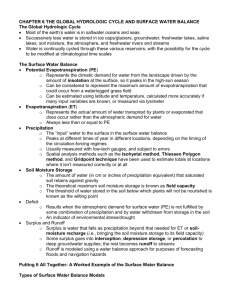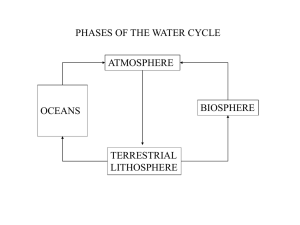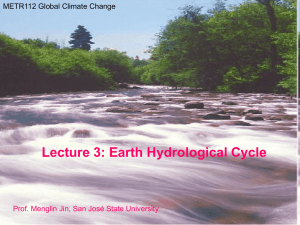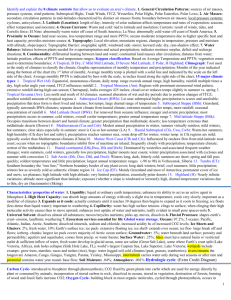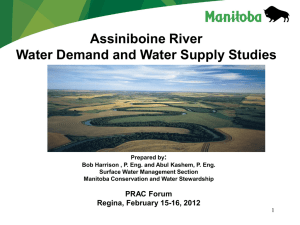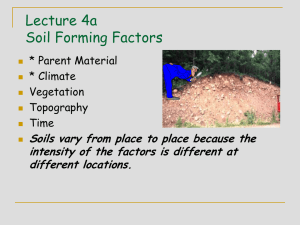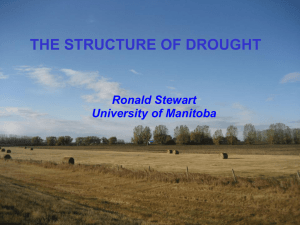Surface water balance
advertisement
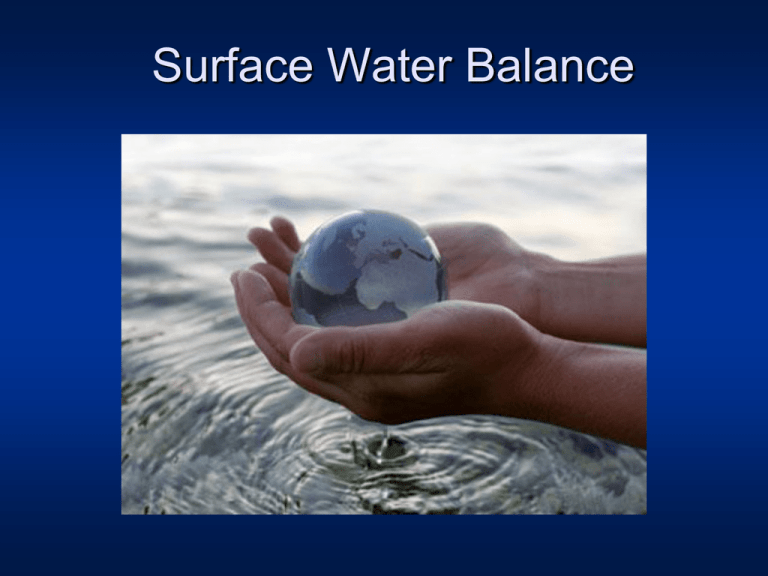
Surface Water Balance Review of last lecture: Surface energy balance Incoming shortwave + Incoming longwave = Reflected shortwave + Emitted longwave + Latent heat flux + Sensible heat flux + Subsurface conduction SWdn =Scos SWup =SWdn LWdn LWup =Tair4 =Ts4 LH=CdLV(qsurface- qair) SH=CdCpV(TsurfaceTair) dT/dt • What is sensible heat flux? What is latent heat flux? Fc = - dT/dz • Bowen ratio B= SH/LH = Cp(Tsurface - Tair) / L(qsurface - qair) provides a simple way for estimating SH and LH when the net radiative flux Fr is available LH=Fr/(B+1), SH=Fr B/(B+1) • Factors affecting soil thermal conductivity • Other heat sources: precipitation, biochemical, anthropogenic The global water cycle Video: Weather Wet Components of global water cycle • • • • • Atmosphere (water vapor, clouds, precipitation) Land (soil moisture, rivers, snow, ice sheet and glaciers) Sea ice Ocean Biosphere (including human beings) Atmosphere: water vapor Atmosphere: Precipitation Inter-tropical convergence zone (ITCZ) Strong rainfall (heating) Weak rainfall GPCP Annual Mean Precipitation for 1979-2005 (mm/day) Land snow/Ice cover provide a reservoir Flow of >1000 rivers on the seven continents Mississippi river Amazon river Yangtze river Land: Soil moisture Flow of ocean currents A significant fraction of the human body is water (~75%) About every 16 days nearly 100% of the water in a human body is exchanged. The remaining: fat, protein, carbonhydrate, other solids So the water we drink may come from … Therefore we need to protect the environment because any pollution we put into the environment may someday come back into our bodies Surface water balance The changing rate of soil moisture S dS/dt = P - E - Rs - Rg + I Precipitation (P) Evaportranspiration (E) Irrigation (I) Runoff (Rs) dS/dt Infiltration (Rg) Evaportranspiration • Is equivalent to latent heat flux • Has four components: E = Eb + Ei + Es + TR Evaporation from inception storage (Ei) Evaporation from bare soil (Eb) Transpiration (TR) Snow sublimation (Es) Evaportranpiration: Penman-Monteith equation where λ is latent heat of evaporation, Rn is the net radiation, G is the soil heat flux, (es - ea) represents the vapour pressure deficit of the air, a is the mean air density at constant pressure, cp is the specific heat of the air, D represents the slope of the saturation vapour pressure temperature relationship, g is the psychrometric constant (=66 Pa/K), and rs and ra are the (bulk) surface and aerodynamic resistances. Soil moisture • Typically expressed as ‘volumetric soil water content’ S = Vwater / Vsoil • Increases with depth • Complicated to measure Root zone Intermediate zone Ground water Soil moisure regimes US Soil moisture map Palmer drought severity index (PDSI) • was developed by Wayne Palmer in the 1960s and uses temperature and rainfall information in a model to determine dryness of soil moisture. • is most effective in determining long term drought (a matter of several months) and is not as good with short-term forecasts (a matter of weeks). • It uses a 0 as normal, and drought is shown in terms of minus numbers; for example, minus 2 is moderate drought, minus 3 is severe drought, and minus 4 is extreme drought. Change of PDSI in the last 100 years PSDI for US in January 2015 A different index: U.S. Drought Monitor Video: Crippling Drought in the Golden State: California Soul • https://www.youtube.com/watch?v=lmUwjk 4S3gw Glacier mass balance Structure of a glacier • A glacier forms when the accumulation of snow and ice exceeds its overall loss of mass by ablation (sublimation and melting). • A glacier can be divided into two zones; the zone of accumulation and the zone of ablation. They are separated by the “equilibrium line”. Accumulation zone • Surface accumulation processes include snow and ice from direct precipitation, avalanches and windblown snow. • There may be minor inputs from hoar frost (radiation frost). • The snow and ice is then transferred downslope as the glacier flows. Ablation zone • Surface ablation processes include surface melt, surface meltwater runoff, sublimation, avalanching and windblown snow. • Glaciers on steep slopes may also dry calve, dropping large chunks of ice onto unwary tourists below. • Other processes of ablation include subaqueous melting, and melting within the ice and at the ice bed Glacier mass balance for the globe Glacier mass balance for different regions Summary: Components of global water cycle • • • • • Atmosphere (water vapor, clouds, precipitation) Land (soil moisture, rivers, snow, ice sheet and glaciers) Sea ice Ocean Biosphere (including human beings) Surface water balance The changing rate of soil moisture S dS/dt = P - E - Rs - Rg + I Precipitation (P) Evaportranspiration (E=Eb+Ei+Es+TR) Penman-Monteith eq Irrigation (I) Runoff (Rs) dS/dt (PDSI, desertification) Infiltration (Rg Darcy’s law) Works cited • http://ffden2.phys.uaf.edu/212_spring2011.web.dir/Jocelyn_Simpso n/Slide3.htm • http://www.antarcticglaciers.org/modernglaciers/introduction-glacier-mass-balance/
